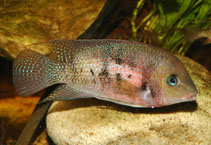| Family: |
Cichlidae (Cichlids), subfamily: Cichlinae |
| Max. size: |
13 cm TL (male/unsexed) |
| Environment: |
benthopelagic; freshwater; pH range: 7 - 8; dH range: 9 - 20 |
| Distribution: |
Central America: Atlantic slope of Panama (Canal Zone, including Chagres River). |
| Diagnosis: |
Dorsal spines (total): 16-18; Dorsal soft rays (total): 9-10; Anal spines: 6-6; Anal soft rays: 7-8. This species is distinguished by the following characters: teeth truncate and labiolingually compressed, incisor-like, with tips rounded (in juveniles, tips are pointed), the biting edges not forming a line; differs from its congeners by having modally 3 rows of scale on cheek (vs. 4 or more), presence of single spot at posteroventral angle of opercle (vs. spots absent, or 1 spot present but not located at the angle in other species except Cryptoheros altoflavus), a medial intensification only of 4th lateral bar on the side of the body (vs. either only on 3rd bar or none), straight dorsal edge of the articular bone (vs. convex), first neural spine retrorsely directed (vs. antrorse in all other species except Cryptoheros spilurus and
C. cutteri), 2 dorsal elements between first two epineural spines (vs. 3); paired fins seldom or never extend posteriorly to the first anal-fin spine; anal-fin spines 6 (vs. 7 or more); dorsal-fin spines 16 (vs. always 17 or more); dorsal- and anal-fin spines total 23 (vs. 24 or more) (Ref. 74403). |
| Biology: |
Inhabits moderately flowing water over a substrate of small stones, sand, rocks, and leaf debris from the forest canopy. Feeds on aufwuchs. |
| IUCN Red List Status: |
Near Threatened (NT); Date assessed: 10 December 2019 (B1ab(iii)) Ref. (130435)
|
| Threat to humans: |
harmless |
Source and more info: www.fishbase.org. For personal, classroom, and other internal use only. Not for publication.
